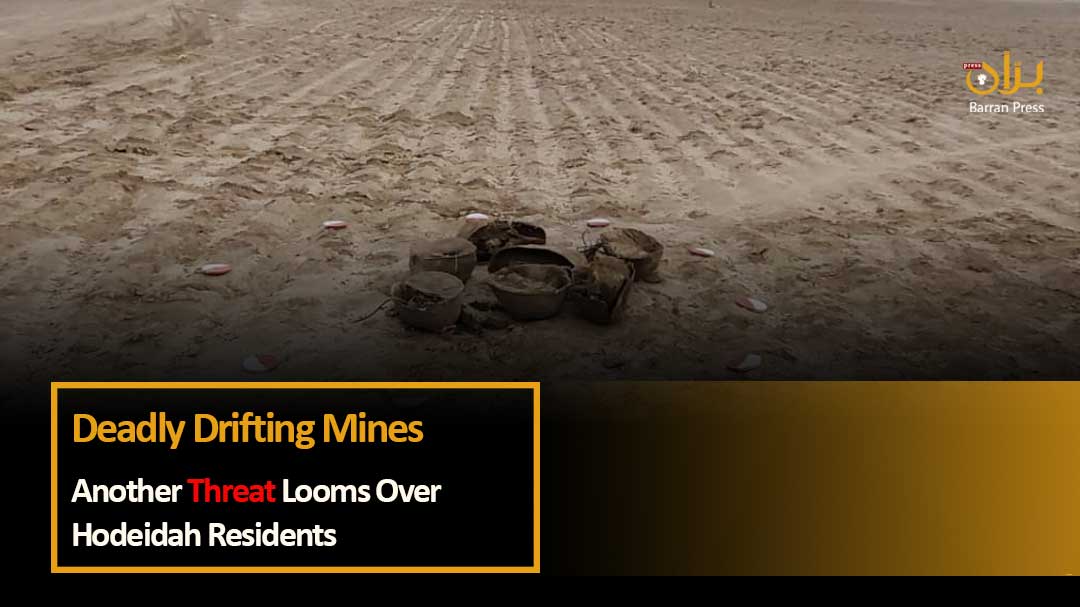


Barran Press
HODEIDAH, YEMEN - Heavy rains and subsequent flash floods in Hodeidah Governorate, western Yemen, have unearthed a deadly new threat: landmines planted by the Houthi group, designated a terrorist organization by the international community.
Local sources said to "Barran Press", on Thursday, August 8, 2024, that the floods have swept away countless mines, scattering them across roads, streets, public facilities, and even residential areas.
Dozens of mines and homemade explosive devices washed away from the valleys, have been discovered in wide areas, including valleys, farms, grazing lands, roads, and populated areas.
Residents south of Hodeidah have found homemade explosives and anti-vehicle mines scattered along the banks of valleys and in agricultural areas after the floodwaters receded.
The discovery has sparked widespread fear among residents, who worry about the danger to themselves and their children, particularly as the rainy season continues and floods persist.
The sources expressed concern about the potential for further mine drift, highlighting the vast number of mines planted by the Houthis in Hodeidah, estimated to be in the thousands. These mines have been laid across agricultural, residential, and grazing areas.
The threat of drifting mines adds to the suffering already endured by Hodeidah residents and the Tehama region as a whole, following the devastating floods. The floods have caused widespread damage, including the destruction of homes and public services. rights activists have urged residents in affected areas to exercise extreme caution, particularly when moving between their homes and farms. They have called for vigilance and urged people to stay indoors to protect themselves from the mines planted by the Iranian-backed group.
Images and videos circulating on social media show dozens of mines swept away by the floods, revealing a hidden danger that has threatened the lives and safety of residents and their livestock.
On Tuesday evening, Hodeidah experienced heavy rains for five hours, followed by unprecedented flash floods, resulting in casualties and significant damage.
In response to the crisis, the Saudi Project for Landmine Clearance in Yemen (MASAM) announced that its Team 20 successfully secured and removed four anti-tank mines from the villages of Heiga Abid and Al-Dhiba, in the Rab'a Al-Souq Center, Hays District, Hodeidah Governorate.
The commander of MASAM Team 20, Engineer Othman Al-Jahouri, stated that his team received reports from the Hays District Security Administration and residents about the presence of mines and war remnants swept away by the floods from the upper reaches of the Marir Valley into residential areas and farms.
He added that Team 20 conducted an emergency operation in the Rab'a Al-Souq area to inspect damaged homes and secure them from mines and other war remnants. The team successfully removed two anti-tank mines from Heiga Abid and two more from Al-Dhiba, both in Hays District.
Al-Jahouri described the challenges faced by the team in accessing flood-affected areas, due to the presence of floodwaters and waterlogged soil, which hindered the deminers' work and caused them to slip.
Earlier, MASAM reported that its Team 26 successfully removed several mines and explosive devices swept away by recent floods in the districts of Mqbanah and Hays in Taiz and Hodeidah governorates, respectively.
A statement released by MASAM's media office stated that the team successfully removed two explosive devices and one mine. One device was removed from the Mqbanah area in Taiz, while the other device and the mine were extracted from the Dhimi Valley in Hays District, Hodeidah.
The commander of Team 26, in a statement released by MASAM's media office, seen by "Barran Press", said that these mines, particularly those equipped with thermal cameras, posed a real threat to the lives of civilians in affected villages such as Al-Suwaihra, Dhim, and Al-Misaybir.
He added that thanks to the reports from citizens and cooperation with local police, Team 26 was able to locate and successfully remove these dangerous mines. He also mentioned that the team conducted intensive awareness campaigns for children and adults on the dangers of mines and how to handle them if found.
The growing fear among residents about the dangers of mines swept away by floods during the rainy season is a pressing concern. Estimates suggest that the Houthi group has planted approximately two million mines and explosive devices across Yemen, making it the most heavily mined country since World War II.
Mine incidents during the nine-year war have resulted in thousands of civilian casualties, primarily women and children while traveling to and from their homes, farms, and grazing lands. The mines are often camouflaged in familiar and deceptive forms, making them difficult to detect or identify, turning them into deadly traps.
UN reports indicate that the Houthi group, internationally designated as a terrorist organization, has planted approximately two million mines in various areas under its control. These mines have resulted in the deaths and injuries of over 20,000 civilians, mostly women and children.
While human rights reports accuse the Houthis of "transforming Yemen into the largest minefield ever, by planting over two million mines," human rights organizations have repeatedly called on the Houthi group to provide maps of the landmines they have planted to organizations working in mine clearance.